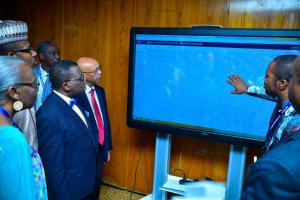How e-Surveillance strengthens health systems in Nigeria
Dr Namadi Lawal is a surveillance officer with the National Primary Health Care Development Agency (NPHCDA). For years, the agency depended on paper-based methods for surveillance and monitoring of disease outbreaks.
When the World Health Organization (WHO) introduced the Electronic Surveillance (e-Surve) approach for active surveillance and monitoring of disease outbreaks, Dr Namadi promptly adopted the method and discovered he was receiving far more accurate information in real time, making his work efficient and timely. “e-Surve is such a wonderful innovation. I can only imagine how much more accurate data I would have collected in a fast and effective manner if I had adopted this approach long time ago,” he says.
The e-Surve involves the use of smartphones to conduct active surveillance and monitoring of disease outbreaks with the help of an electronic checklist. It is an innovative approach which aims to strengthen disease surveillance activities at all levels in Nigeria as well as improve the quality and documentation of active surveillance visits. Local Government Area (LGA) Disease Surveillance and Notification Officers (DSNO) are equipped with configured smart phones and supported monthly with voice and data recharge to conduct active surveillance in health facilities and communities within their coverage areas. This ensures timely, evidence based implementation and submission of active visits conducted.
“This is remarkable progress as it shows where we can actually reach for surveillance with geo-coordinates”, said Dr Isaac Adewole, Nigeria’s Minister of Health as he was presented a dashboard of e-Surve during the opening ceremony of the African Regional Certification Commission hosted by Nigeria (June 18-22).
At present, not all diseases are notified to health workers or health facilities. Notifiable diseases that are attended to at health facilities are sometimes not reported by health workers. In such cases, unreported communicable diseases can result to active transmission from infected to healthy individuals. Active disease surveillance as opposed to passive surveillance, increases detection of unreported priority diseases. DSNOs who are the frontline workers that conduct active surveillance visits to health facilities and communities. Without mobile technology, such visits used to be cumbersome to track and analyze for prompt action.
Instead of paper work, e-Surve helps the government and partners to monitor active surveillance visits based on approved guidelines, provides evidence-based visits and tracks visits conducted by DSNOs not only to health facilities but also to communities. The content of the visit is easy to analyze, and feedback given timely to improved quality of surveillance.
Real-time reporting stems spread of diseases
Reports submitted from the field in real time and identifying missed cases of notifiable diseases, including those of public health importance, are reviewed and followed-up immediately. This institutes a preventive approach to disease outbreaks rather than a reactive one. As at 30 May 2018, about 18,840 active surveillance visits to health facilities, with location captured, had been recorded across the 18 implementing states and 3,276 suspected cases (730 acute flaccid paralysis, 1,850 measles, 149 suspected Yellow fever, 100 neonatal tetanus and 447 cerebrospinal meningitis) previously unreported from the health facilities have been identified and investigated.
Early detection of cases calls for swift intervention as well as prevention of the spread of diseases within and outside the communities.
Apart from e-Surve, other interventions using smart phones like Auto-Visual AFP Detection and Reporting (AVADAR), Integrated Supportive Supervision (ISS) also contribute to enhance disease detection and reporting.
Enhanced support for government
Dr. Sume Gerald at the WHO Nigeria office, stated that “e-Surveillance in Nigeria is government-led and driven, supported by WHO. Specifically, WHO builds capacity of DSNOs and their assistants, procures smart phones for e-Surveillance and provides airtime for uninterrupted use of the phones for active surveillance in their respective LGAs.”
It is worth noting that about 20,930 community members have already been sensitized on identification and notification of priority diseases in 2018. All these are geared towards supporting government to strengthen the surveillance system in Nigeria at both health facility and community levels so that no cases of vaccine preventable diseases under surveillance are undetected and responded to on timely basis.
Kindly follow us on Social Media:



